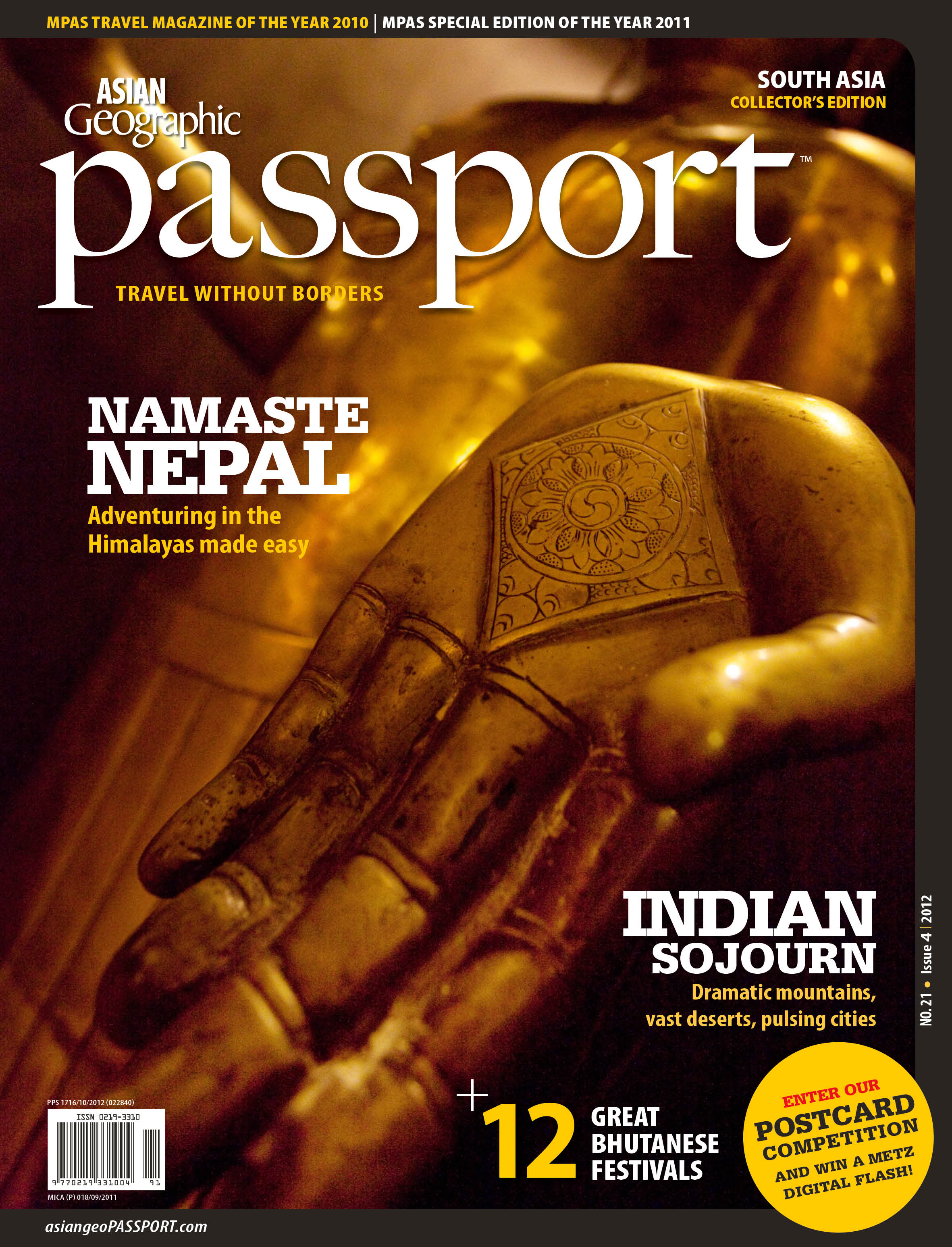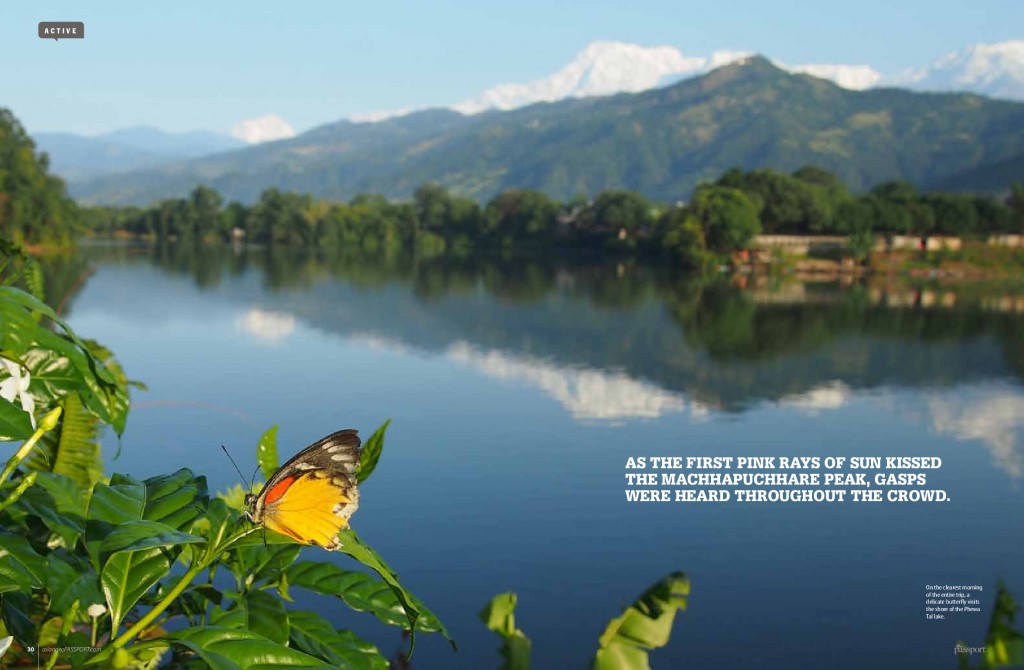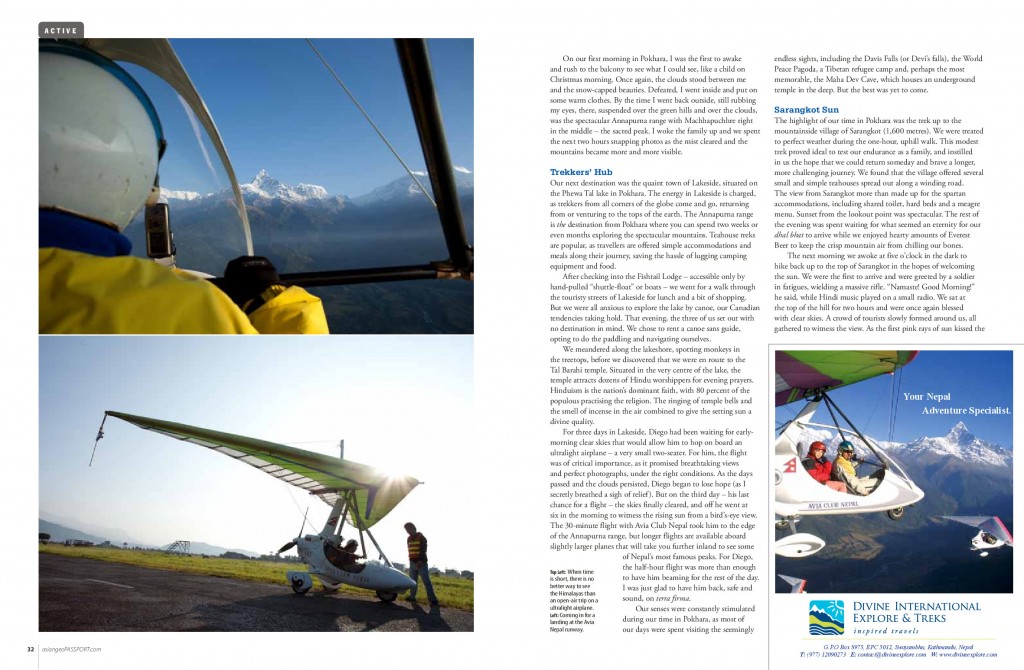Text
Niky Lewis
Photos
Diego A. Garcia
Published
Asian Geographic Passport Issue 4 (2012)
Click here to view the exciting video of the family in action on their Nepal adventure!
Not just for hard-core trekkers, Nepal fills a small family with awe, after just one week.
When one thinks of Nepal, one often envisions long arduous treks to places such as Mount Everest base camp or the Annapurna Circuit – journeys that take weeks or months to accomplish with plenty of planning and physical training. When my husband, Diego, suggested we travel to Nepal for a one-week holiday in October with our 8-year-old daughter Carmen, I was sceptical. I imagined that we would end up staying at the sort of bedbug-ridden budget homestays that we used to frequent together in our backpacking days of the pre-Carmen era. Although I had often dreamed of visiting the Himalayas, I foolishly assumed that such a trip might be pointless without the formidable strength and endurance that one requires to conquer the peaks. But my assumptions were unfounded.
One of the first and most important decisions we made was to engage an adventure travel specialist. We wanted to ensure that our seven days would be spent having fun, rather than worrying about where we would stay and how we would get around. So when we arrived in Kathmandu in the early afternoon, we were immediately greeted by two gentlemen from Divine International, who would be our guides throughout the trip. They adorned us with marigold garlands, gave us a very thorough rundown of our plans and sent us on our way with our main guide, Tshering, and a driver.
We quickly left the crowded streets of Kathmandu behind us as we made our way up through the snaky roads towards our hilltop destination. Our first stop was Nagarkot, a lookout point with plenty of hotels that lure visitors with promises of breathtaking views of the Himalayas. The air became clearer, the steep drop-offs more precarious, and the trees less and less tropical. To cope with vertigo, I took comfort in two things: ginger pills and the easy chatter of our driver and guide in an unrecognisable yet soothing language – Nepali. Carmen was fast asleep after half a hour, despite the incessant honking of our driver, whose job it was to make his presence known to oncoming traffic at each bend in the road. It’s safe to say that the crisp mountain air combined with the purple flowers dotting the hillside and the peaceful-looking people of Nepal were enough to set my heart stirring already.
At 2,175 metres above sea level, Carmen soon woke up and observed that her breathing was slightly laboured, her rationale being that “we’re closer to outer space, where there’s no oxygen at all!” The atmosphere in Nagarkot was delightful and we were thrilled to be able to sport our newly purchased jackets while sipping hot tea and eating steamy dhal with rice on the patio overlooking the valley. We were not, however, treated to the spectacular view of the Himalayas, which was jealously guarded by the clouds.
Road to pokhara
The next morning we set out at 7:30am for an eight-hour journey, by land and water, towards the lake town of Pokhara. As the mist cleared from the valley, we made our way back down the snaky roads while soldiers-in-training were making their way up the hill, lugging all manner of weaponry and supplies. Seeing the determination of the famed Nepalese soldiers, one is reminded of the hot political turmoil that the people have endured for decades. Since the mid-18th century, Nepal had been ruled by the Shah dynasty of kings all the way up until 1990. Challenged by Maoist parties, King Birendra implemented a parliamentary monarchy with the king acting as the head of state while a prime minister took charge of the government. By 2008, after years of turmoil and civil war, a democracy was finally established and still stands today.
We arrived at a spot on the Trisuli River where we were to meet our river-rafting guide who would take us two hours downstream, and a bit closer to our destination. More advanced rafters may choose to venture out for up to 10 days down one of Nepal’s many rafting rivers, including the Seti, Sun Kosi River or Karnali River. Most rivers are off-limits from June to August as the monsoon season wreaks havoc on the waters. Throughout the rest of the year, from September to May, most rivers boast Category 3 to Category 4 swells. Upon seeing the rushing waters that we were about to take on, my nerves were, naturally, beginning to rattle.
We were greeted by a jolly-looking young man named Som, our paddles, life jackets and helmets strewn about the rocks on the side of the road. After fitting our lifejackets – an especially tiny vest had to be sourced for Carmen – we proceeded down a steep hill towards the water. Tshering, of surprisingly small stature, proved his mountaineer’s strength and agility when he whisked Carmen off her feet and carried her down the steep slope without so much as a stumble.
River Rush
We piled into the inflatable boat, Diego, Carmen and myself in the front row. Behind us was Tshering and a gentleman we had picked up along the way (I suspect he was a friend in need of a ride to Pokhara), and at the very back was Som and a young Nepalese man to whom we were never introduced. With five strong men on board, I was assured that Carmen would be taken care of. Being my first time river rafting, and with my precious eight-year-old daughter on board, needless to say I was anxious to hear the safety drill. Knowing that we were embarking on an “easy” stretch of the river, Som gave us a brief summary of our commands and precautions, and we were on our way. Not 10 seconds into our paddle, Som yelled out “More power!” as we slammed into a wall of water and got drenched by the cold mountain-fed river. Carmen was bounced out of her seat while steadfastly gripping her blue safety rope and the only thing she yelled out was: “Where’s my shoe?” That first adrenaline rush had us on our toes straight away, as Carmen’s shoe rested safely underneath her. The rest of the ride was a combination of perfectly calm with bouts of rough water that sent our bodies flying and our hearts racing. We loved every minute and had mixed feelings when the ride was over.
After our exhilarating paddle, we changed into dry clothes and enjoyed lunch overlooking the river before piling back into the car for another three-hour drive towards Pokhara. I was on constant lookout for any sign of a snow-covered mountain and was once again denied visual access for the rest of that second day.
On our first morning in Pokhara, I was the first to awake and rush to the balcony to see what I could see, like a child on Christmas morning. Once again, the clouds stood between me and the snow-capped beauties. Defeated, I went inside and put on some warm clothes. By the time I went back outside, still rubbing my eyes, there, suspended over the green hills and over the clouds, was the spectacular Annapurna range with Machhapuchhre right in the middle – the sacred peak. I woke the family up and we spent the next two hours snapping photos as the mist cleared and the mountains became more and more visible.
Trekkers’ Hub
Our next destination was the quaint town of Lakeside, situated on the Phewa Tal lake in Pokhara. The energy in Lakeside is charged, as trekkers from all corners of the globe come and go, returning from or venturing to the tops of the earth. The Annapurna range is the destination from Pokhara where you can spend two weeks or even months exploring the spectacular mountains. Teahouse treks are popular, as travellers are offered simple accommodations and meals along their journey, saving the hassle of lugging camping equipment and food.
After checking into the Fishtail Lodge – accessible only by hand-pulled “shuttle-float” or boats – we went for a walk through the touristy streets of Lakeside for lunch and a bit of shopping. But we were all anxious to explore the lake by canoe, our Canadian tendencies taking hold. That evening, the three of us set out with no destination in mind. We chose to rent a canoe sans guide, opting to do the paddling and navigating ourselves.
We meandered along the lakeshore, spotting monkeys in the treetops, before we discovered that we were en route to the Tal Barahi temple. Situated in the very centre of the lake, the temple attracts dozens of Hindu worshippers for evening prayers. Hinduism is the nation’s dominant faith, with 80 percent of the populous practising the religion. The ringing of temple bells and the smell of incense in the air combined to give the setting sun a divine quality.
For three days in Lakeside, Diego had been waiting for early-morning clear skies that would allow him to hop on board an ultralight airplane – a very small two-seater. For him, the flight was of critical importance, as it promised breathtaking views and perfect photographs, under the right conditions. As the days passed and the clouds persisted, Diego began to lose hope (as I secretly breathed a sigh of relief). But on the third day – his last chance for a flight – the skies finally cleared, and off he went at six in the morning to witness the rising sun from a bird’s-eye view. The 30-minute flight with Avia Club Nepal took him to the edge of the Annapurna range, but longer flights are available aboard slightly larger planes that will take you further inland to see some of Nepal’s most famous peaks. For Diego, the half-hour flight was more than enough to have him beaming for the rest of the day. I was just glad to have him back, safe and sound, on terra firma.
Our senses were constantly stimulated during our time in Pokhara, as most of our days were spent visiting the seemingly endless sights, including the Davis Falls (or Devi’s falls), the World Peace Pagoda, a Tibetan refugee camp and, perhaps the most memorable, the Maha Dev Cave, which houses an underground temple in the deep. But the best was yet to come.
Sarangkot Sun
The highlight of our time in Pokhara was the trek up to the mountainside village of Sarangkot (1,600 metres). We were treated to perfect weather during the one-hour, uphill walk. This modest trek proved ideal to test our endurance as a family, and instilled in us the hope that we could return someday and brave a longer, more challenging journey. We found that the village offered several small and simple teahouses spread out along a winding road. The view from Sarangkot more than made up for the spartan accommodations, including shared toilet, hard beds and a meagre menu. Sunset from the lookout point was spectacular. The rest of the evening was spent waiting for what seemed an eternity for our dhal bhat to arrive while we enjoyed hearty amounts of Everest Beer to keep the crisp mountain air from chilling our bones.
The next morning we awoke at five o’clock in the dark to hike back up to the top of Sarangkot in the hopes of welcoming the sun. We were the first to arrive and were greeted by a soldier in fatigues, wielding a massive rifle. “Namaste! Good Morning!” he said, while Hindi music played on a small radio. We sat at the top of the hill for two hours and were once again blessed with clear skies. A crowd of tourists slowly formed around us, all gathered to witness the view. As the first pink rays of sun kissed the Machhapuchhare peak, gasps were heard throughout the crowd. This spectacular, simple, predictable natural event, performed every morning at dawn, held the attention of every person for hours, a hopeful reminder that we humans are still in awe of our precious planet.
The final leg of our journey took us to the capital of Nepal, Kathmandu (1,400 metres). With only one evening to spend in the densely populated capital city, we opted to visit the iconic Boudhanath Stupa for sunset prayers, where hundreds of worshippers gather daily to circumnavigate the 1,000-year-old structure. Declared a UNESCO World Heritage Site in 1979, the stupa is considered one of the holiest Buddhist sites in Nepal. Although only 10 percent of Nepalese practise Buddhism, the site has great historical significance and attracts people of all walks of life. Now a popular tourist destination, the stupa is surrounded by restaurants, shops and small hotels where one can spend hours taking in the culture and sacred energy of the place.
After an incredible six-course dinner at the Krishnarpan restaurant in Dwarika’s Hotel, the sad reality dawned on us that our week was over. We promised one another we would return to Nepal very soon, and we left feeling inspired and uplifted. The next day, as we soared through the air heading back home, we were treated to one last miracle: there, to the left of the aircraft, was a perfectly clear view of the highest peak on earth – Mount Everest, at 8,848 metres.
Although one week is certainly not enough to see and appreciate all that Nepal has to offer, it was more than enough to leave a profound impression on our little family. In those seven days we had seen and experienced more than we could have hoped or even dreamed, from simple hikes to raging rivers, and even, to the very top of the world.
HOW TO GET THERE: Many international carriers fly direct to Kathmandu, or connect with regional carriers like SilkAir (departs Singapore three times per week), as well as Jet Airways (via India) and Thai Airways. Nepal’s domestic airlines are constantly changing. Expect delays if you are taking domestic flights. Driving can be treacherous but the views are spectacular. Adventure travel experts Divine International (divineexplore.com.sg) can make your life easy and exciting at the same time.
WHEN TO GO: The best time to visit Nepal is in the dry season, from October to April, while the air is clear. In May and June the temperatures start to rise above 30 degrees Celsius, and combined with the extreme dust, can make life uncomfortable. From July to September, the monsoon clouds roll in and obscure the mountains, while the rains muddy the trails.
WHERE TO STAY: Aside from the rustic teahouse experience that shouldn’t be missed along any trek, you’ll want to spoil yourself now and then. Fishtail Lodge in Pokhara (fishtail-lodge.com) sits directly on Phewa Tal Lake and offers an eclectic mix of luxury and an appreciation of the rustic. For true indulgence at the end of the journey, try the incomparable Dwarika’s Hotel in Kathmandu (dwarikas.com), a living museum and testament to ancient Nepali traditions. Ask about their excellent special packages.
WHAT TO EAT: The food in Nepal is generally not quite as piquant as can be found in neighbouring India, but is delicious nonetheless. Be sure to try the dhal bhat, the national dish of rice and lentils, no matter where you end up. For the ultimate in Nepali fine dining, the Krishnarpan restaurant at Dwarika’s Hotel in Kathmandu will leave a lasting impression.






